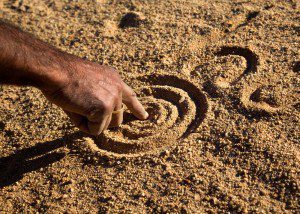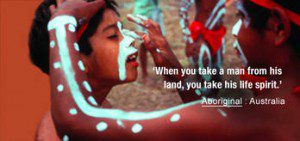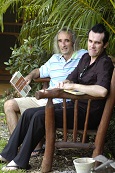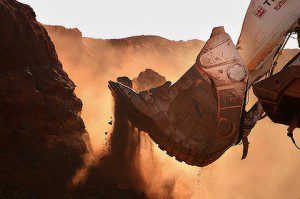By Steven Strong with Andy Whiteley
Contributing Writers for Wake Up World
Over 45,700 Years Old – and Who Cares?
We received a phone call from Owen Torres regarding what seemed to be a terrible state of affairs that was causing a great deal of stress for some Original Elders and Custodians of the Old Ways. Owen was ringing on behalf of himself and Elder Eddy McPhee; their shared concern was as tragic as it was endemic in a country where governments would routinely sell the nation’s soul for another hole in the ground, and the mining revenues they feel make any excess excusable.
We then spoke to Eddy, who gave us a blow by blow account of how he believed Atlas mining company and representative body Yamatji Marlta Aboriginal Corporation (YMAC) had divided the community – and were planning to destroy sacred sites and the accompanying Dreaming tracks. His plea was simple; “we need help – and quickly”.
[pro_ad_display_adzone id=”110028″]
There was no choice to be made. We asked Eddy how quickly he wanted us there. His reply of “yesterday” left us in no doubt time was short. We promised to come immediately, but within minutes of hanging up the practicalities set in and a pressing financial imperative began to loom on the horizon. Around four weeks from now we will be able to afford to attend this site.
In the meantime we can do exactly what we am doing now; raising public awareness of this operation and its underlying Original truth.
One Hole, Plenty Pictures and So Few Words
To that end, this article is solely about the public report cobbled together from the work of a group of archaeologists, detailing the fleeting and superficial visit they made inside the cave. According to the marketing collateral produced for the community, less than 1% of the cave floor was examined, one pit was completed and another abandoned due to their self-imposed time constraints. The one page document has more space devoted to photographs (11) and diagrams than actual words, at around 520 words in length and needing less than three minutes to casually read.
As brief as it is, the introduction resembles a serious archaeological treatise in providing a date, location, site description and nominating the parties involved in the investigation. In the only reference to any Original meaning, tradition or lore, the author made note the Ganga Maya Cave is interpreted as “house on the hill”. Claimed to be a joint-investigation between “Njamal Traditional Owners” and “Big Island Research”/“Atlas Irons Limited”, it was also conceded that this is “the largest cave in the Abydos Region”. But that appears to be a major understatement, a pattern that is repeated throughout this report. In fact the cave is over 10 metres high, 12 metres in width and reaches back 40 metres. More importantly, the artefacts the team did uncover during their brief visit provide evidence of the world’s oldest known occupation.
You can view the pamphlet here: Excavations at Ganga Maya Cave.
The Descent Past Mediocrity Begins
Beyond the opening description, the paper serves no further function except to raise questions the archaeologists were either unwilling or too inexperienced to comprehend. From the quality of the information provided, we believe they were unable to grasp the many-fold implications of the important discoveries they actually uncovered.
One pit of 139 cms was successfully dug, a second abandoned at 70 cms, and third pit “located immediately adjacent to Square 1 was only able to be excavated to a depth of 33 cms below the floor surface in the time available”. The crucial indicators to the real aspirations of this dig are predicated around two phrases: “only able” and “time available”. The immediate question that comes to mind is – how much time was allocated? Clearly not enough.
Many sites take months to complete, some years; very, very few can be measured in minutes. But at Ganga Maya Cave, it seems the archaeology that supports the approval of this mining operation was funded to barely scratch the surface.
 Let’s examine the precious little that was recovered and analysed. In the only complete pit, they found stone artefacts, charcoal and bone and at a depth of 127 cms (12cms above the base rock platform) and recorded a date of 45,704 years through Carbon 14 with 95.4% probability. But entries supplied under the heading “So what does this tell us?” show a complete lack of awareness of the big picture. Although conceding (correctly) this may well be evidence of the longest continuous presence at one site in Australia as it spans from over 45,000 years to 1,700 years ago, the implications of this find are entirely overlooked.
Let’s examine the precious little that was recovered and analysed. In the only complete pit, they found stone artefacts, charcoal and bone and at a depth of 127 cms (12cms above the base rock platform) and recorded a date of 45,704 years through Carbon 14 with 95.4% probability. But entries supplied under the heading “So what does this tell us?” show a complete lack of awareness of the big picture. Although conceding (correctly) this may well be evidence of the longest continuous presence at one site in Australia as it spans from over 45,000 years to 1,700 years ago, the implications of this find are entirely overlooked.
The Big Picture
What we consider to be two of the most important archaeological papers written in the last 30 years are predicated upon Africa settlers reaching Australia 50,000 years ago. We have previously written about the first genome study conducted on a 100 year-old full-descent lock of Original hair. Acknowledging that the mtDNA extracted to be at least 75,000 years-old, at least 40,000 years before Asian and European races evolved, the researchers were placed in a quandary when deciding whether the Africans or Original Australians were first; the decision to choose Africa was heavily influenced by the belief Australia was “settled 50,000 years ago.”
When Professors Alan Wilson and Rebecca Cann published their seminal paper “The Recent African Genesis of Humans”, their “molecular clock” measured the timing and evolution of modern humans. A pivotal assumption that directly influenced the timing mechanisms was the belief that “the aboriginal (sic) populations of New Guinea and Australia are estimated to have been founded less than 50,000 to 60,000 years ago”. Even though both researchers later recanted, admitting Australia, not Africa, was the place from which Homo sapien sapiens evolved, these dates are still universally accepted amongst traditional academia.
That being the case, an occupation date greater than 45,700 years attributed to a site no less than 1,000 kilometres from any potential northern entry site doesn’t make sense. If water-born travellers did populate this continent, which we do not accept, highly respected archaeologist Josephine Flood’s description of these pioneers being “beach-huggers” seems entirely appropriate. Such adventurers would keep close to the coast and venture inland at on inviting waterways, seeking locations full of animal life, lush vegetation and fertile soil. In contrast, the west coast of Australia, and in particular the Pilbara is barren, infertile and until the abundance of minerals and ores was discovered held few attractions to any non-Original people. With due respect to the Original tribes of this area, it is the least inviting landscape for people who are accustomed to living by the sea. So impoverished was this place, when William Dampier first set foot on the west coast of Australia, he was utterly dismayed with what he encountered, claiming the local Originals to be “the miserablest people in the world”.
In what only adds to the irregularities of any traditional account, this site is over 150 kilometres from the coast. Inhospitable and devoid of natural waterway, this area of of north western Australia, logically, would be the last piece of land migrating Africans would choose to settle. But according to the archaeology, “1760 generations” were continuously occupying a location that one would expect should have been intermittent and perhaps beginning 30,000 years ago.
What Next? Nothing But a Big Hole
The conclusion in this pamphlet, titled “What Next?” is an exercise in futility. Less than 200 words in length, we see the same motif repeated: “further excavation will tell us”, “further excavation will open windows into the lives of some of Australia’s earliest inhabitants”, and so it continues. What further excavation? This document details excavations that were undertaken in April 2013! Yet no further work has been done since this assessment was concluded due to self-imposed time constraints. Why did they even bother? This collateral acknowledges more than once the need to follow up, yet there seems to have been no intention to return to dig or consult, and no recommendations for future actions.
From our point of view the fundamental flaw in this paper are four words: “house on the hill”. It is nowhere near enough. Whenever we go on a site first rule is to consult the Elders and Custodians of the Old Ways. That is mandatory and pure common sense. They are the keepers of the Original Lore and history, and possess knowledge we do not have. Although this release cites the contribution of Yamatji Marlta Aboriginal Corporation, it simultaneously demonstrates that Original protocols were not met – something we will discuss in more detail in a forthcoming article. Without mention of Original historians, Dreaming tracks, nearby sites or even the sacred rock pool less than 500 metres away, what was presented really is a waste of paper and ink.
In conclusion, our concerns are twofold.
First and foremost, the archaeology needed to be done at this site is less than 1% complete. The archaeology that was uncovered is incredibly significant, and further work must be done before mining operations can legitimately continue. (The Original tribal people tell us the area is full of ancient stories.)
More importantly, if archaeology of this magnitude and a sacred historical tradition can be sacrificed for monetary gain with the support of government and the silent consent of the people, our nation has truly lost its soul.
 It has to stop here and now. We are selling our nation’s soul and Original heritage. Over two hundred years of theft without compassion must come to an end, and we cannot think of a more deserving site than Ganga Maya Cave to draw a line in the soil.
It has to stop here and now. We are selling our nation’s soul and Original heritage. Over two hundred years of theft without compassion must come to an end, and we cannot think of a more deserving site than Ganga Maya Cave to draw a line in the soil.
There is only one proper way to conclude any commentary on this site. The void has to be filled, and the Original defenders of the land must have the right to present their case. As a first step it seems appropriate to ask Eddy to explain why this outrage must stop now.
“The destruction of Aboriginal history seems to be a normal procedure in Australia our ancestors fought in the past to save and protect it. We the present generation are carrying on with the same struggle. This cave that was discovered in the Pilbara Region (Ganga Maya) represents all things sacred to Aboriginal history and it goes back 45,000 years plus … More research needs to be done by an independent archaeologist and Nyamal traditional owners to protect the area.
“The mining company are going to destroy Ganga Maya Cave and surrounding areas, which has more caves and a water hole close by which has a significant cultural connection to the area.
“Mining has to stop.”
About the authors:
 Steven Strong is an Australian-based researcher, author and former high school teacher. Together with his son Evan, his work is to explore the ancient story of the Original people, a narrative that was almost lost to aggressive European colonisation.
Steven Strong is an Australian-based researcher, author and former high school teacher. Together with his son Evan, his work is to explore the ancient story of the Original people, a narrative that was almost lost to aggressive European colonisation.
Andy Whiteley is a former corporate manager turned writer, editor and co-founder of Wake Up World. An advocate of peaceful (r)evolution, Andy believes we are on a necessary path (albeit bumpy) to a renewed social model grounded in love, transparency, individuality, sustainability and spirit.
Connect with Andy at Facebook.com/JoinWakeUpWorld.
This article © Wake Up World.
[pro_ad_display_adzone id=”110027″]







